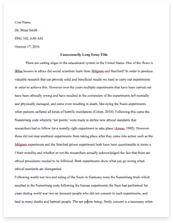Childhood from different sources

- Pages: 4
- Word count: 839
- Category: Childhood
A limited time offer! Get a custom sample essay written according to your requirements urgent 3h delivery guaranteed
Order NowI have selected appropriate secondary material which links closely to my topic of investigation. My first source is Neil Postman who has written a book about the ‘Disappearance of childhood’ (1982). Within this book he discusses how children are growing up to fast, and talks about how it is growing more difficult to distinguish between what is acceptable for a child and for an adult. “Adults watch the same films and TV programmes and listen to the same music as their children”.
Postman blames the mass media for children growing up too fast therefore children today have a “loss of childhood” which is my first concept. This also shows we how easy it is for children to be influenced by the adult world and how are they meant to see what is acceptable for a child if they are introduced to these at a young age. Postman also says, “The media help to define modern childhood and they are now the agents of its destruction”. The adult world is now a place where children and adults are now sharing the same norms and values, therefore children are loosing their childhood and becoming little adults.
Philippe Aries talks about how the children in medieval society were “Little Adults”. Children had the same status as adults as there leisure and work times were they same. Children are ‘little adults’. Aries argues that ‘They are young humans between the ages of 7 and 15; they were not seen as children. Their cultures lacked the concept of childhood. ‘ This source illustrates that children were treated the same as adults and did not have a childhood. However, Aries argues that today children have a separate status. Social construction’, Aries believes that childhood is created; this is how society believes children should be treated. Society sees children as innocent and the need to be protected with stern discipline. The main argument by Aries is, ‘I argue that children of the 20th century really are children, but that they are children by our choice. ‘ This says that because society does not want children to become ‘little adults’ like there were in the medieval times, we have created a definition of childhood.
No longer are children and adults tarred with the same brush, but are having different norms and values, children are being protected for longer and seen as vulnerable. Sue Palmer author of “Toxic childhood” talks about how children no longer have the same definition of “play” as the older generations did. “What’s happened is a sort of sedentary, screen based existence has crept up on children. They used to be free range and now they’re practically battery children, living indoors, experiencing through the medium of a screen”.
My concept for Sue palmer is ‘Toxic Children’. She shows us how children in today’s modern society are run by computers and technology. They are intoxicated by things that are virtual. But in a society where you mustn’t talk to strangers or you mustn’t play in the street or near water, what is left for children to do. The fun has been taken out of going out side to play; virtual technology has given children the safe way to play. Sue Palmer thinks that children should go outside and enjoy life now while there are no worries in life, “scarred knees are rather good”.
The Arch Bishop of Canterbury talks about how children are being treated like young adults, he talks about how big companies are turning children into customers, “Dr Williams also attacks the Disney empire, saying it is turning children into consumers, by marketing strategies which link toys, sweets and comics to films. ” Children, when they are old enough should make up there own mines about films and other advertising schemes. Children should not be pressured into making choices at a young age. “He accuses the corporation of creating characters in children’s films which are inappropriately sexual. This makes children see things at a younger age that our parents and older generations. The pressure for children should be them focused on exams not having to choice which toy is “cool” in today’s modern life. An article from the BBC news says that modern life “poisoning childhood”. This article published on the 12/09/2006 is dozens of teachers and children’s authors writing a letter to the daily telegraph. “Childhood creativity is being stifled by a combination of junk food, school targets and mass marketing, a group of authors and academics have claimed”.
This shows how children are under pressure and are know expected to do and achieve a lot more. SATs results and GCSE results are know published in the papers and on the internet making school push there children a lot harder so that they get an acceptable place on he achievement ladder. “There is absolutely no question that there is a profound link between children, their poor performance and a poor diet”. If our society took more interest on children there well being and not making sure there school get a good review children would have a happier upbringing.










